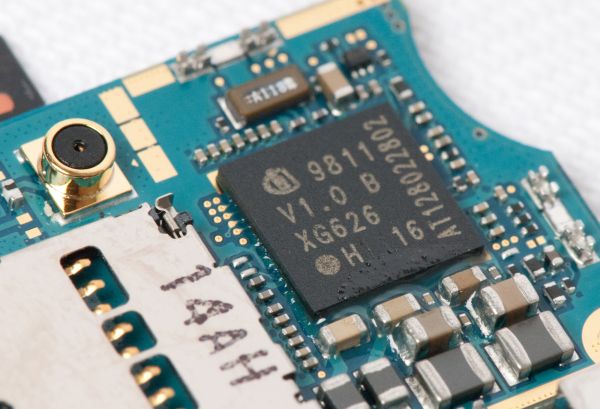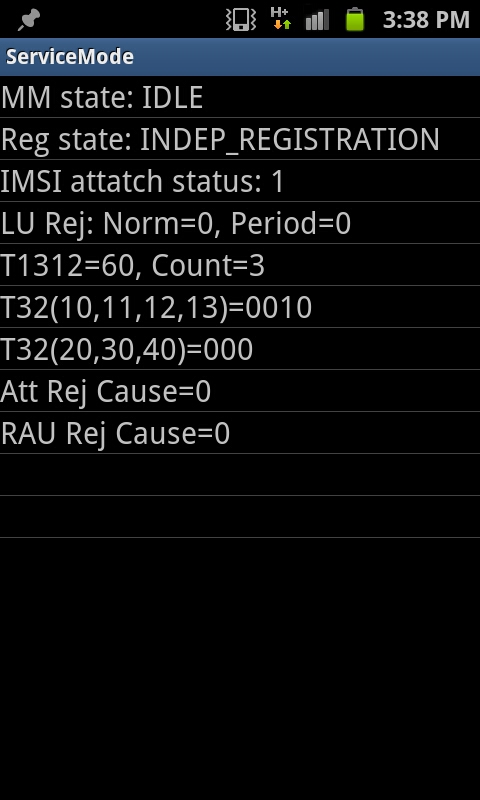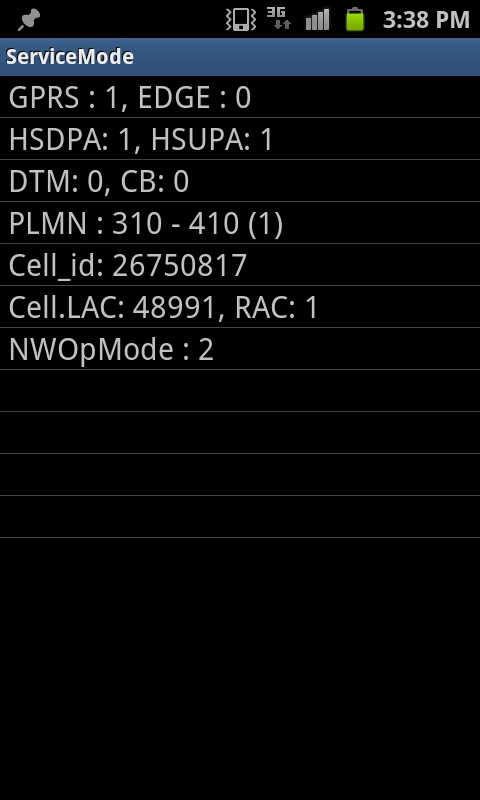Samsung Galaxy S 2 (International) Review - The Best, Redefined
by Brian Klug & Anand Lal Shimpi on September 11, 2011 11:06 AM EST- Posted in
- Smartphones
- Samsung
- Galaxy S II
- Exynos
- Mobile
Cellular
So we’ve already mentioned that SGS2 contains Intel/Infineon’s latest and greatest X-Gold 626 baseband, which supports HSDPA 21.1 (Category 14) and HSUPA 11.5 (Category 7) support, though SGS2 actually only supports HSUPA 5.76 (Category 6) according to Samsung. Of course, this international edition includes quadband UMTS and GSM support.
I used the SGS2 on AT&T in the USA, and my particular market only has PCS 1900 MHz support, meaning both GSM and WCDMA carriers both only sit in the PCS 1900 MHz band. I remember that one of the first things I did with the SGS2 at MWC was check whether all of the same excellent dialer codes worked, and thankfully they do.
Samsung continues to have the absolute best field test / engineering menus of any handset vendor, and on the SGS2 dialing *#0011# gives you access to information about the current connected carrier, band, RCC state (what signaling state you’re in) and signal (ECIO and RSCP at the bottom). There’s a field marked HSPA+ used which I think has confused some people - this shows 1 when data is being transacted (DCH state). I should also mention that I’m incredibly grateful that SGS2 shows all the correct and proper status indicators for network connectivity at the top - 3G, H, and H+ appropriately, instead of this trend in the USA of calling every UMTS connectivity state “4G” - ugh. As an aside, it’s normal to see 3G when in the idle state, and then a negotiation up to H+ when in the DCH (Dedicated CHannel) state if you’re on an HSPA+ network. I haven’t seen H+ show when in the FACH (Forward Access Channel) state.
| Samsung Galaxy S 2 - Network Support | |||||
| GSM/EDGE Support | 850 / 900 / 1800 / 1900 MHz | ||||
| UMTS/HSDPA/HSUPA Support | 850 / 900 / 1900 / 2100 MHz | ||||
| HSDPA/HSUPA Speeds | 21 Mbps / 5.76 Mbps | ||||
| Baseband Hardware | Infineon/Intel X-GOLD 626 HSPA+ | ||||
I ran 318 speedtests on the SGS2 using the Ookla Speedtest.net application, and did our usual thing and come up with a histogram showing throughput for those tests. Again, this is more indicative of AT&T speed than what the SGS2 is capable of, given that I’ve seen other SGS2 users seeing much faster on other WCDMA networks - I’m insanely jealous of all of you. I tested throughout my 1900 MHz market in Tucson, Phoenix, and on the positively dreadful 850 / 1900 WCDMA network in Las Vegas, which remains completely unusable even when CES or any other conference isn’t happening. But I digress.
First up is downstream, which develops a nice little normal distribution when you run enough tests like we’ve done here.

Again this is really more indicative of what you’re going to see in the markets I’ve tested in with AT&T. Speeds top out at 7 or 8 Mbps if you’re very lucky, with performance most of the time between 2 to 4 Mbps. The average here is 3.11 Mbps, with a standard deviation of 1.56 Mbps. That sounds about right to me given how many of these things I run when I’m not even testing a phone.
I’m also aware of the whole AT&T HSDPPB (“4G” unlimited data) versus DPPB (3G unlimited data) SOC code thing and the corresponding difference in APN. I used them interchangeably for a week or so and honestly didn’t see any difference.
Upstream is next, where AT&T continues to employ lots of artificial shaping, limiting upstream to at maximum 1.7 Mbps.

I’ve heard speculation that AT&T is limiting the HSUPA category to 2 or 3 (which is 1.46 Mbps), or category 5 (2.00 Mbps), but neither of those line up nicely with the artificial-looking wall that seems to exist on AT&T at 1.7 Mbps. I’m very positive however that there’s shaping going on here, the last remaining question is whether it’s enforced by only allowing a certain HSUPA category, or shaping somewhere else in the network. It’d make sense to me at least to do the latter of those two. It’s disappointing because there’s definitely the potential for much speedier upstream than what I see here.
Last is latency, which looks pretty typical, though there are some outliers in the data entirely from the abysmal Las Vegas performance tests:

Average latency works out to be 147 ms, which is pretty par for UMTS as far as I’m concerned, unless you’re lucky enough to be somewhere with much better backhaul and a flatter IP-based network architecture.
For the most part, I’m very pleased with SGS2’s cellular connectivity situation, though there’s a bit more to talk about. I noticed that sometimes cellular connectivity will stop and become unresponsive for anywhere between a few seconds, and minutes at a time, requiring a battery pull or lots of patience before working again. Toggling airplane mode doesn’t work when that happens, and usually it’s manifested by the data-type indicator disappearing. I’m not sure what the story is here, but it seems like I’ve seen a lot of Samsung phones having data sessions randomly lock up and then come back after a while, lately.
In addition, Samsung makes the mistake of going with a signal bar visualization with very compressed dynamic range. Since the whole iPhone 4 debacle, I’ve seen something of a trend towards a strict linear scale (which makes more sense), but SGS2 definitely doesn’t go that route. It’s not a huge deal however, just something to be aware of. I’m willing to overlook that issue considering that getting the real story on connectivity is no harder than dialing *#0011# and looking at the real number.
I’ve also read a bunch of accounts which claim that the SGS2 has iPhone 4-like deathgrip, which needless to say piqued my interest. Of course, I’ve been religiously measuring unintended signal attenuation on every device I’ve encountered ever since, so the SGS2 doesn’t get spared that treatment.
| Signal Attenuation Comparison in dB - Lower is Better | ||||||||
| Cupping Tightly | Holding Naturally | Holding in Case | On an Open Palm | |||||
| Samsung Galaxy S 2 | 18.4 | 5.9 | - | 12.2 | ||||
| Droid 3 | 16.0 | 11.3 | - | 5.0 | ||||
| HTC Sensation | 15.0 | 10.0 | 8.0 | 0.0 | ||||
| Samsung Droid Charge | 10.0 | 10.0 | 5.0 | 0.0 | ||||
| HTC Thunderbolt - LTE | 5.3 | 2.5 | - | 4.4 | ||||
| HTC THunderbolt - EVDO | 6.5 | 0.8 | - | 7.2 | ||||
| Verizon iPhone 4 | 16.5 | 15.5 | 9.0 | 7.9 | ||||
| LG Optimus 2X | 13.7 | 9.3 | - | 5.9 | ||||
| Nexus S | 13.3 | 6.1 | - | 4.3 | ||||
| Droid 2 | 11.5 | 5.1 | - | 4.5 | ||||
| BlackBerry Torch | 15.9 | 7.1 | - | 3.7 | ||||
| Dell Streak | 14.0 | 8.7 | - | 4.0 | ||||
| Droid X | 15.0 | 5.1 | - | 4.5 | ||||
| AT&T iPhone 4 | 24.6 | 19.8 | 7.2 | 9.2 | ||||
| iPhone 3GS | 14.3 | 1.9 | 3.2 | 0.2 | ||||
| HTC Nexus One | 17.7 | 10.7 | 7.7 | 6.7 | ||||
The data is actually quite interesting, with the SGS2 showing more than the 15 dB average attenuation in worst case, and an unusually high open-palm result as well. If you go back to the disassembly and look at that antenna module, you can start to see why this is so bad. It’s located right in the plastic bulge, and the active region of the antenna printed on the plastic is less than a mm separated from the exterior. The result is that though there’s obviously no galvanic contact (there’s a plastic insulating layer between), there still is some coupling and attenuation in the near field right here.
I honestly don’t think it’s an iPhone 4-level problem at ~18 dB in this worst case (which I’ll remind you literally involves both hands clasped around the device as close as possible), but it’s still more than average.














132 Comments
View All Comments
numberoneoppa - Wednesday, September 14, 2011 - link
Guys, that mysterious notch you write about is not for straps, it's for phone charms, and it's arguably my favourite feature of samsung phones. (In korea, phone charms can be used for more than just cute things, one can get a T-money card that will hang here, or an apartment key).Tishyn - Wednesday, September 14, 2011 - link
I spend hours every week just browsing through reviews and tests comparing devices and vendors. This is one if the most interesting and most comprehensive review I've read for a veery long time.I especially enjoyed the rendering part and how it relates to the ultra mobile device market. Thumbs up!
milli - Wednesday, September 14, 2011 - link
Brian / Anand, why are you so reluctant to test chips from this company? ZiiO tablets, sporting the ZMS-08, are available for a while now and i'm sure Creative would send you the new Jaguar3 tablet (ZMS-20) if you guys would ask for it.The ZMS-20 has 26 GFlops ... faster than anything you've tested till now. The ZMS-40 coming in Q4 doubles that number!
I'm an old school IT technician and I for one don't understand your lack of interest. The GPU's in these chips are based on technology that Creative acquired with the 3DLabs purchase.
rigel84 - Thursday, September 15, 2011 - link
Just a quick tip: You can take a screenshot by pressing the power and home button at the same time.If you double tap your home button it will bring the voice talk feature.
While watching video clips just press the power button to disable the touch sensitive buttons.
Swipe your finger to the left on contact name to send him a message
Swipe you finger to the right on the contact name to dial the contact.
To see all the tabs in the browser just pinch inside twice :)
If you experience random reboots when you drop it on the table, or if you are leaning towards things or running, then try to cut a piece of paper and put it under the battery. It happens because the battery shortly looses connection to the pins. If you check XDA you can see that many people has this problem, and I had it too. I was experiencing many random reboots whenever I had it in my pocket, but after I pit a piece of paper below the battery they all disappeared.
A few things...
- GPS is horrible if you ask me. Unless I download the data before with gps-status then it takes ages. Mostly 15-30 seconds with 2.3.3 (no idea if the radio got updated in the release)
- Kies AIR is HORRIBLE! It's on pair with realmedia's real player from 10 years ago. Crash on crash on crash and sluggish behavior.
- I don't know whether it's the phone or not, but I've been missing a lot of text messages after I got my Galaxy S2. I'm on the same net, but along with the poor GPS reception I'm suspectiong the phone :(
- There is a stupid 458 character limit on textmessages, and then they are auto-converted to an MMS message. There is a fixed mms.apk on XDA (requires root) or you can download something like Go SMS Pro (still free) on the market, which removes this stupid limit.
ph00ny - Thursday, September 15, 2011 - link
OddI haven't seen any posts about the battery disconnect issues and if you've been browsing the xda forum, probably saw my thread about dropping my phone on concrete twice...
As for Kies AIR, i've used it twice and my expectation was low to begin and it wasn't that bad. Some things were definitely slow but it's a good start
-GPS for me has always been solid. I even used it on multiple trips in less than ideal location, not a single glitch even with shoddy cell reception.
ciparis - Tuesday, September 27, 2011 - link
I've been using Sprint's SGS2 (Epic 4G) for less than a day, but already there are some annoying points which I'm surprised aren't mentioned in this review:1) The digitizer lags behind finger movement.
In the web browser, when your finger moves, there is a disconnected rubber-band effect before the screen catches up with your finger. This is visible in the browsing smoothness video as well, and it's very noticeable in actual use. Coming from an iPhone 4, it feels cheap and broken.
2) Back/Forward navigation often ignores the previous scroll point.
If you spend some amount of time reading a page you arrived at from a link (it seems to be about 10 seconds or so), hitting back doesn't take you back where you were previously reading from -- instead of returning you to the page position where the link was, it drops you at the top of the page. This makes real web usage tedious. On the Sprint, the timing seems to be related to when the 4G icon indicates sleep mode: hit back before the radio sleeps and you are returned to the right spot. In actual use, this rarely happens.
3) The browser resets the view to the top, even after you've started scrolling.
When loading a page, there's a point in which the page is visible and usable, but it's technically still loading (which can go on for quite a awhile, depending on the page). It's natural to start reading the page and scrolling down, but typically the phone will randomly jerk the scroll back up to the top of the page, sometimes several times before the page is done. This is unbelievably annoying.
I suppose expecting an Apple level of polish prior to release is unrealistic, but Samsung seems hell-bent on positioning themselves as an Apple-level alternative; even the power brick looks like they took the square Apple USB charger, colored it black, and slapped their logo on it. The point being, they're inviting direct comparison, and it's a comparison their software team isn't ready to deliver on -- certainly not out of the box.
ciparis - Tuesday, September 27, 2011 - link
How are you supposed to use this phone if the keyboard is covering up the text fields, there's no "next" button to get to the next field, you can't see what you're typing, and there's no button to make the keyboard go away?Case in point: go to Google News and click on Feedback at the bottom of the page. There's no scrolling room at the bottom, so the keyboard obscures the fields; I was unable to send feedback to Google that their news site was opening every link in a new bowser window on a mobile phone (...) despite my account having the preference for that set to "off", because I couldn't navigate the form fields.
mythun.chandra - Wednesday, September 28, 2011 - link
Just realized there are no numbers for the Adreno 220 in the GLBench 2.1 offscreen tests...?sam46 - Saturday, October 1, 2011 - link
brian,please tell me which one of these smartphones is the best.i wanna purchase one of them so,pls help me in deciding.b1cb01 - Wednesday, October 5, 2011 - link
I love the green wallpaper on the first page of the review, but I can't find it anywhere. Could someone point me to where I could find it?